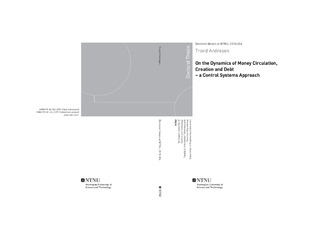| dc.description.abstract | This thesis develops and explores a way of understanding a macroeconomy; as a set of "nodes" interconnected via a network of money flows. A metaphor for this is a body with a circulatory blood system, furnishing the different organs with the necessary oxygen and nourishment. Later on in the thesis we will study the effects of indebtedness, which -- with the "body" metaphor -- may be compared to increasingly draining blood from the organism and sending it back in again - but as a non-flexible, damaging process.
A prerequistite for the analysis is that the country in question issues its own currency (it is not in the eurozone or dollarised).
The main (hopefully useful) contributions are as follows:
1. An understanding of time lags and time dispersion of flows in monetary circuits, and how this relates to money velocity and liquidity preference.
2. An aggregation approach that gives an alternative and straightforward connection between micro- and macroeconomic dynamics. This might v be useful in the persistent discourse within the economics field about "microfoundations for macro".
3. A separate analysis of the advantages of time-continuous models, as opposed to the commonly used time-discrete models in stock-flow economics. All models are stock-flow consistent and achieve correct accounting -- which is easier to ensure in continuous time.
4. It is argued that debt and money growth rates from commercial banks following a Bank of International Settlements (BIS)-type capital adequacy restriction will be inversely proportional to the mandated minimum capital/asset ratio. This is shown mathematically, and is a further and more precise contribution to the increasing recognition in the economics field that commercial (licensed) banks create money when they lend. It is shown that if banks only lent out of their net interest income, the money growth rate would be a magnitude lower than what empirical data say -- while the "inversely proportional" rule gives a growth rate of a magnitude that corresponds well with empirical data. It is demonstrated how a theoretical new bank can bootstrap itself from a start only with the new owners investing their high-powered money ("HPM"), and then continue with issuing an exponentially increasing loan flow, accompanied by the creation of credit money ex nihilo at the same rate.
5. It is argued that credit money growth via licensed banks is a good thing -- in the sense that a system where all debt growth were accompanied by net money growth at the same rate, would not end up in debt crisis. Non-bank financial institutions (NBFIs) which extend loans, but do not create money, are the problem.
6. A distinction between "non-discretionary" (forced) and "discretionary" (more or less self-decided) money outflows from agents is introduced and exploited in a crisis model.
7. A new stock-flow model, and simulations of debt-related crisis collapse mechanisms, are introduced and explored. Financialisation is represented as a slowly time-growing parameter, inspired by Minsky's Financial Instability Hypothesis. An increased debt burden leads to more insolvencies, leading to banks and NBFIs holding back in giving new loans. This again reduces flows in the real economy, in the next round leading to pessimism and increased liquidity preference among firms, capitalists and households.
Increasing liquidity preference is represented by the time lags of these groups (subsystems) in the model. This is inspired by J M Keynes' and Irving Fisher's writings. New loans not being given and increased general liquidity preference result in a damaging positive feedback that brings the system into crisis and collapse.
8. In the crisis model, the government is "embedded" as nodes and extra parallel flows in the circulatory real-economy network. This enables an inclusion of the government debt burden together with the private real sector debt burden.
9. The advantages of a purely electronic monetary system is argued. There is no more a need for bank branches for anything but vetting of potential borrowers (and perhaps giving advice on what sort of savings to choose -- among these a spectrum of paper that could be offered at the Central Bank). Depositors can all have all types of accounts at the central bank.
10. Electronic money enables a system where all circulating money is Central Bank money, and thus cannot be lost. Such a system is proposed and described. It also has the property that only bank owners take the hit when a bank becomes insolvent. The system does not need government and central bank bailouts, and is extremely robust against crisis. Depositors' money cannot be lost, hence here will be no bank runs in such a system.
11. Modern Mone(tar)y Theory ("MMT") is supported. The control tool proposals in this thesis depends completely on the country issuing its own currency, also central to MMT. Dollarised or eurozone countries cannot implement the proposals. But see point 13 below.
12. It is explained how electronic money for the first time enables precise control against inflation and deflation, in contrast to today's sole, blunt and slow-impact interest rate tool.
13. Electronic money can be introduced easily, fast and cheaply. Systems where the main transaction tool is the mobile phone, are up and running -- not the least in some poor countries -- with an excellent track record. One could easily introduce a parallel electronic national currency in a dollarised or eurozone country that suffers from a debt-related crisis, and this will give a way out to solve problems. This is explained and discussed. | nb_NO |

